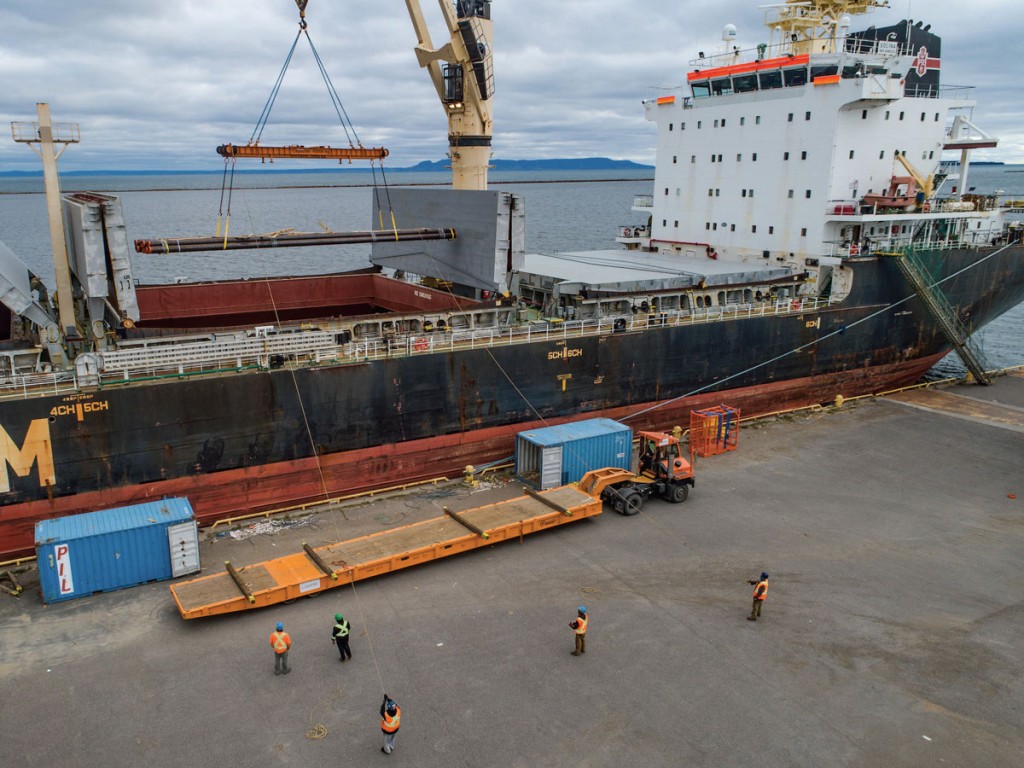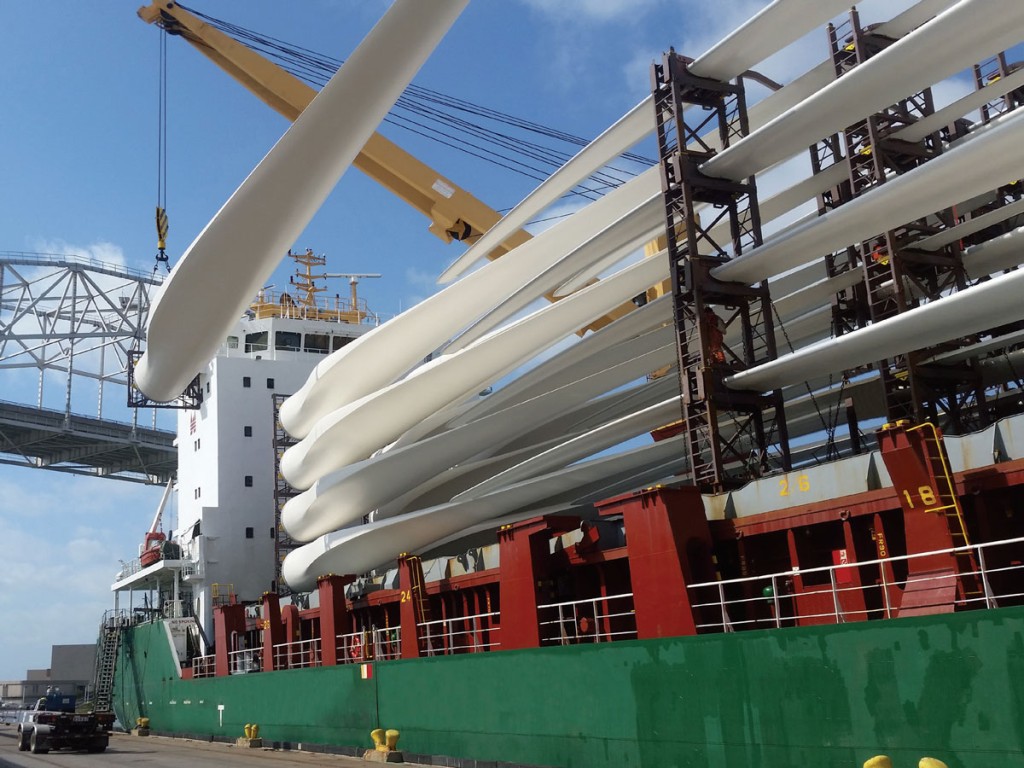In both western and eastern Canada, breakbulk activity is on the rise – as seen in strong shipments of steel, forest products and construction materials as well as wind energy components. The overall project cargo sector is re-bounding from production delays and other pandemic-related challenges.
At the Port of Vancouver, Canada’s largest port and leading Pacific gateway, the breakbulk numbers are showing significant growth with first half 2021 volume up by 36% at 10 million metric tons. Breakbulk activity is brisk at two dedicated terminals: DP World Fraser Surrey and Lynnterm operated by Western Stevedoring.
As an indicator, in the period to end June, forest products throughput increased by over 15% to 12 million tons. Machinery, industrial parts and construction materials were on growth trajectories exceeding 10%.
Commenting on present project cargo and breakbulk shipping trends on the St. Lawrence Seaway, Bruce Hodgson, Director of Market development, told AJOT: “In 2021, shipments to the steel industry have increased, buoyed by the economic recovery following COVID-19. Imports of steel and slab have increased by over 80% from what was handled in the previous year.”
Cargo volumes through the St. Lawrence Seaway and Canadian Great Lakes ports remained robust in September as ships delivered critical commodities and products without the delays or supply chain disruption seen in other trade gateways, according to the latest results. From March 22 to September 30, overall cargo volumes via the Seaway totaled 24.1 million tons, up 2.6% from the same period in 2020. The total was boosted by increases in cross-border trade of cargoes like stone (55%), cement (7%) and gypsum (18%) for construction purposes. Year-to-date iron ore shipments, up 26%, showed no sign of slowing down as demand from Canadian and overseas steel producers continued. General cargo shipments, including iron, steel and aluminum, are also up 59% at 2.3 million tons compared to this time last year. Ship operator McKeil Marine delivered over 41,600 tons of Canadian aluminum in September - markedly up from 16,200 metric tons in September 2020. The majority of these volumes are being shipped to Toledo, Ohio. The improvement comes after U.S. steel tariffs were lifted in 2019/2020, although volumes have not yet completely returned to normal levels.
“What we’re seeing in cargo at our ports makes us optimistic for the path the regional economy is on,” says Ian Hamilton, president and CEO of the Hamilton-Oshawa Port Authority. “In particular we’re pleased to see strong manufacturing-related indicators like steel-making commodities and finished steel. Compared to this time last year, HOPA Ports has received 25% more iron ore (two million tons) and more than a million tonnes of steel has moved through the ports so far this season. This is an encouraging sign of demand in the manufacturing and construction sectors.”
“Keep your eyes open for an upcoming movement of pre-fabricated jail cells which will be moving to both Kelowna, B.C., and Thunder Bay, Ontario,” Hodgson said.
On the tip of Lake Superior, the Port of Thunder Bay has handled its largest shipments of steel rail, and steel cargo volumes which are expected to double by the end of the year - signaling a strong construction demand in the West.
“Overall, general cargo and project cargo (via the Seaway) remain strong and have recorded the best volume in many years and is expected to finish strong,” Hodgson predicted.
Undeniably, the Port of Thunder Bay acts as a strategic hub for dimensional and project cargo for destinations in Western Canada, thanks essentially to an expanded Keefer Terminal which attracts multipurpose vessels of the likes of BBC Chartering and Spliethoff. Total general cargo to end October amounted to 30,543 tons versus the year-earlier 16,885 tons.
In October alone, nearly 8,000 tons of European steel pipe were discharged at Keefer, where cargo is stored in a large laydown area before being trucked to Alberta.
Elsewhere on the Great Lakes, the Port of Windsor has witnessed a sharp climb in its breakbulk steel volumes, reportedly handling as much cargo in the first half of 2021 as in all of 2020.

Big Presence of BBC Chartering
A world leader in project/breakbulk shipping, BBC Chartering has had a major presence in the Great Lakes since opening an office in Montreal in 2004.
“Since that time, we have seen substantial growth in the Canadian market with 2020 being our busiest year to date in terms in the number of vessels and port calls in the Great Lakes and the St. Lawrence River,” says Ross Fletcher, Owners Representative for BBC Chartering in Canada. “Our volumes this year have been down as some projects that were planned have been delayed due to COVID 19, but all indications are that these projects should resume in 2022 and we look forward to a busy Lakes season next year.”
Fletcher added: “Wind turbine components, including blades and towers are the major commodity we handle in the Lakes and St. Lawrence River, but we also see regular shipments of other commodities including transformers, steel coils and bars, yachts, railcars, mining equipment, and dismantled cranes.
“Our multi-purpose vessels are well suited to call all ports in the Lakes, including Duluth, Burns Harbour, Hamilton, Thunder Bay and Bay City. In the St. Lawrence River, Trois-Riviéres and Bécancour are our regular ports.”
Based on the St. Lawrence River at Trois-Rivières, heavy-lift specialist Groupe Bellemare is continuing to move wind turbine components in large quantities along the Gaspé Peninsula. Between 2016 and May 2021, Bellemare Transport had delivered 4,663 blades over a combined distance surpassing 620,000 miles, according to the company’s website. The blades travelled 150 miles from LM Wind Power in Gaspé to Fabrication Delta in New Richmond, Quebec before being loaded on trains (holding 48 blades) headed for Texas.
Among terminal operators, Montreal-based Federal Marine Terminals reports robust volumes in almost every terminal in the Great Lakes, East and Gulf Coast, handling diverse products ranging from steel, forest products and project cargoes.
“An exciting development as we promote our end-to-end services within the Fednav Group is Fednav ships carrying yachts and steel from Asia to FMT Port Manatee,” noted Matthew McPhail, vice-president sales and services.

The Breakbulk Landscape Viewed by Logistec’s Rodney Corrigan
Meanwhile, in an e-mailed statement, Rodney Corrigan, president of LOGISTEC Stevedoring Inc., commented on market trends and the current landscape with a keen focus on what’s next in supporting customers, supply chain partners and communities post-pandemic across its expanding network in the United States and Canada.
“One of the first things we saw when COVID hit,” Corrigan began, “was how quickly the global supply chain was impacted. What we also saw, as we adjusted to this new normal was the remarkably sudden comeback of goods and projects and the strong rebound in manufacturing production. This surprising rebound caught the world off guard. As an essential service and as a key supply chain partner, LOGISTEC found innovative solutions to help customers thrive in the rebound and address supply chain challenges by creating new service offerings. Along with our customers, we continue to embrace the relaunch of a post-COVID economy together.”

Turning to opportunities related to infrastructure, breakbulk and project cargo, Corrigan noted: “Governments have announced major investments in infrastructure with $180 billion over the next twelve years. Large-scale infrastructure projects that include transit, green initiatives like renewable energy, wind energy and housing projects require products like steel, lumber, plywood, all of which are handled by LOGISTEC.
“With demand for these products reaching historical peaks, many major breakbulk terminals are at capacity and customers are facing challenges. This is where our extensive network reach, project cargo and breakbulk expertise has proven valuable to our customers. We are working closely with them to identify more efficient routes to bypass congestion. We want to get their product closer to destination and save time, leveraging our Canadian ports including those along the Great Lakes and St. Lawrence Seaway.
“Renewable energy, including the wind sector, will continue to accelerate as we are seeing major investments in clean energy. Over 120 countries have committed to moving to net-zero emissions by 2050. LOGISTEC is an industry leader in handling wind energy components, from towers to blades to nacelles. We were there at the very beginning of the renewable energy boom and have developed specialized expertise combined with leading-edge safety and quality protocols.
“Our marine terminals are strategically located in the US Gulf coast, situated near existing, new and proposed wind projects, allowing our customers to benefit from both our expertise and access to the most efficient routes possible to destination wind projects on land and off-shore. These key differentiators allow us to capture more and more market share.
“Perhaps the most important and now permanent post-pandemic market trend is the intensification of environmental, social, and corporate governance priorities (ESG). At LOGISTEC, we already contribute to 12 of the 17 UN ESG goals and we know that maritime transport is the most ecological means of transport there is. LOGISTEC continues to leverage sustainable technologies to reduce our environmental footprint, including using hybrid and electric trucks, equipment and cranes. As the marine operator with the most Green Marine certified terminals across North America, our teams are continuously exploring ways to optimize our operations.”
Concluding his comments, Corrigan stated: “We are confident the year ahead will be one of growth. The last 18 months have certainly not been normal. But then again, as science journalist Ed Yong elegantly put it, ‘Normal led to this’. May the next year bring an end to this pandemic and the beginning of a “not-so-normal” lifestyle in which we finally decide it is time to build a fairer, more inclusive and sustainable society.”

Follow us on social media: